Tour Shudu| From the taste of Chengdu to the charm of Sichuan
order
One Chengdu was opened in nine days, and thousands of households and doors entered the painting. In the eyes of Li Bai, the great poet of the Tang Dynasty, Chengdu was naturally natural, beautiful and prosperous, and the land of abundance continued to flourish. Chengdu became famous for its reputation as the land of abundance and the capital of leisure. Speaking of Chengdu, the first impression in mind is delicious food. Sichuan cuisine is famous for its spicy taste, but it is not just spicy taste.
In Chengdu, time passes slowly. Elegance and fashion are Chengdu's unique and wonderful cultural characteristics, and optimism and tolerance are Chengdu's inclusive cultural temperament. An optimistic and casual lifestyle, making a cup of green tea and holding a good book, has run through the lives of Chengdu people through the past generations, and has also given birth to Chengdu's strong artistic atmosphere. Chengdu is a fascinating capital of leisure and literature.

[Trip Preview]
DAY 1: Chengdu--Kuanzhai Alley--Memory of Eastern Suburb
DAY 2: Chengdu-Giant Panda Breeding Base
DAY 3: Chengdu-Aba County
DAY 4: Aba County--Lianbao Yeze--Aba County
DAY 5: Aba County--Gemo Temple--Manzetang Wetland--Shenzuo Village--Tongyangding--Aba County
DAY 6: Aba County-Chengdu
a Chengdu
(1) If you go to Chengdu for the first time, it is best to slowly adapt to the food from slightly spicy food. Otherwise, it will be a fly in the ointment if your stomach is uncomfortable. It is also necessary to bring some stomach medicine. It is recommended that whether you eat Sichuan cuisine or hot pot, ordering a cool tofu pudding or a bottle of Vie is particularly effective in alleviating the impact of spicy food.
(2) Every famous restaurant in Chengdu has a large number of people waiting in line almost every day. It is recommended to control the play time well and not waste travel time on queuing. Eat early and enjoy early.
(3) There are many small scenic spots in Chengdu, and buses are a relatively common means of transportation. Prepare more change in advance or apply for a local bus pass.
4. Download a map APP to find attractions, food, hotels, and websites. It is very practical. Every time you visit a strange city, you have many opportunities to use it.
(5) There are special tourist buses in the urban area to and from each major attraction. For example, it costs more than 30 yuan to take a taxi from Panda Base to the urban area, and only 2 yuan to take a through train to other attractions in the urban area.
1. In order to cope with altitude sickness, take anti-high-altitude drugs such as Hongjingtian one week in advance.
2. The weather in Tibetan areas is changeable, so we must pay attention to cold and warm. In high altitude areas, colds or fever will aggravate.
3. While taking beautiful photos, you must pay attention to safety, especially on the mountains.
4. Photography is prohibited in the main hall of Gemo Temple, and aerial photography can also be taken outside at will.
5. On the way to Manzetang Wetland, the second half of the way is difficult to walk and it takes a long time to go back and forth. Bring food and tents in advance.
Chengdu is a city that loves and knows how to eat. Whether in fashionable neighborhoods or Gufang alleys, there are many specialty restaurants with different cooking techniques and flavors such as Sichuan cuisine, hot pot, skewers, and barbecue. If you don't do your homework well for the first time in Chengdu, it will inevitably be confusing. With one mouth, if you can really eat and love it, you must be meticulous. Where can you go to eat? What to eat? How to eat? It's a science.
Niuhua Babo Mala TangChengdu Niuhua Babo Malatang is located on the 1st floor of Dongfang Times Mall, No. 43 Tianxianqiao South Road. It is very close to Dongmen Bridge Station of Metro Line 2. This is an authentic old Chengdu restaurant. You can smell it when you walk by the roadside. The aroma of malatang. Dating friends to hot skewers and drink beer on weekends is probably the most relaxing pastime for people after a busy week.


The inside of the room is also in a classical Chinese style. The walls are painted with various microcosms of old Chengdu. Under the warm light, small wooden tables and small benches are full of nostalgic features.


There are countless skewers of various meats, vegetables, soy products, and eggs on the display cabinet. Just pick up whatever you like. Finally, you can pay the bill by counting the lots. There are multiple flavors at the bottom of the pot, and the price is paid individually.


Both oil and dry dishes can be controlled if they like spicy food. When the bottom of the pot is served, the room is full of spicy and strong aroma. I can't wait to put the ingredients into the pot. The transparent bright oil wraps the strings, which is delicious, and my saliva is already uncontrollable. I can't help but start to swallow.





Environment: ★★★★★ ④
Service: ★★★★★★★ ★
Taste: ★★★★★★ ★
Recommendation index: ★★ ★★
Per capita consumption: 70 yuan
Hot pot is always indispensable in the streets and alleys of Chengdu, and a large number of people also fall in love with Chengdu flavor because of hot pot. A delicious hot pot restaurant can always attract many diners. Zhouxiaoyu Cold Pot Fish is one of them. It is located at No. 136-139 Qunxing Road, Chengdu (opposite Qunxing Garden). It is said that many people come after Zhouxiaoyu's sign.


It's raining in Chengdu today. There are still many diners in the restaurant. The dining environment is not bad. The service staff are very enthusiastic. Cold pot fish and bullfrogs are the hallmarks of the restaurant.


Vegetables and fruits can be eaten for free and unlimited, provided that each person orders more than one catty of the main pot. If it does not reach one catty per person, the vegetables and fruits will be charged separately. In fact, everyone can easily eat one catty, and the price is still very affordable. It is suitable for bringing three or five friends together.

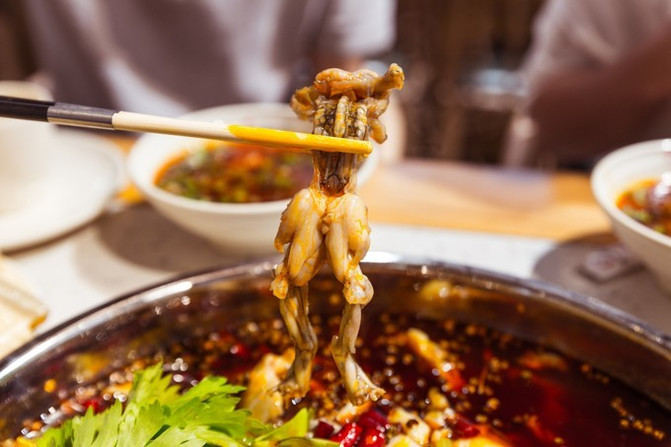

Environment: ★★★★★ ④
Service: ★★★★★★★ ★
Taste: ★★★★★★ ★
Recommendation index: ★★ ★★
Per capita consumption: 60 yuan
Chengdu is the birthplace of ancient Shu civilization, one of China's top ten ancient capitals, and a city with profound cultural heritage. There are many scenic spots, historic sites and cultural landscapes distributed in every corner of Chengdu, some new and some old, from the wide and narrow alleys from the Qing Dynasty to the present, to the memories of the eastern suburbs of the modern times, etc. Oh, there is also our national treasure giant panda. These cultural roots that have been passed down through the ages are the soul of a city. If you want to truly understand a city and fall in love with a city, the first thing is to understand its history and culture.
kuanzhai alleyKuanzhai Alley is located near Changshun Street, Qingyang District, Chengdu City, Sichuan Province. It consists of a wide alley, a narrow alley, and a well alley arranged in parallel. It is all antique courtyards made of indigo bricks and tiles. It is also a relatively large-scale ancient street of the Qing Dynasty left in Chengdu. Together with Daci Temple and Manshu Yuan, it is called the protected district of Chengdu's three major historical and cultural cities.


In the fifty-seventh year of Kangxi, after putting down the Jungar Rebellion, more than a thousand soldiers were selected to garrison Chengdu, and Mancheng was built on the basis of Shaocheng at that time. In the Qing Dynasty, only the Manchu Eight Banners lived in Mancheng. After the decline of Manchu Qing Dynasty, Mancheng was no longer a restricted area and people could enter and exit freely. Some foreign merchants took the opportunity to open pawn shops near Mancheng and purchased large quantities of the property of the flag bearers. A unique pattern has been formed in which descendants of flag men, dignitaries, and peddlers live all over the city. At this time, the wide alley was called Xingren Hutong, the narrow alley was called Taiping Hutong, and the well alley was called Ruyi Hutong.

After the Revolution of 1911, Zhao Erfeng, the governor of the Qing Dynasty, later surrendered power and demolished the city wall of Shaocheng. Some high-ranking officials and dignitaries came here to build residences and private houses. Yu Youren, Tian Yongyao, Li Jiayu, Yang Sen, Liu Wenhui and others successively settled here. Chiang Kai-shek also came here, allowing these ancient buildings to be preserved. In the early years of the Republic of China, the city managers at that time changed the hutongs into alleys.
Kuan Alley is a leisure and living area and a reproduction of old Chengdu life. There is the Old Chengdu Life Experience Hall on the wide alley, where both the customs and old Chengdu folk customs are here.


There is a profession in Chengdu called ear picking, which is ear picking. They can be seen in many famous streets and alleys, and the wide and narrow alleys are no exception. There are three great joys among the people: picking ears, pinching feet, and bathing. Ear picking is to use various ear picking tools to stimulate the inside and outside of the ear hole, so that people can enjoy and relax after itching and tension! In addition to cleaning ear holes, it can also relieve stress and enjoy.




There are many buildings in the narrow alleys from the late Qing Dynasty and the early Republic of China, including some Western-style buildings left by the church. Narrow alleys are slow living areas, showing the courtyard culture of old Chengdu. Most of these courtyards are occupied by stylish bars and restaurants. Tourists and cultural people hang out in the alleys and spend the entire afternoon leisurely and feel the pause of time.



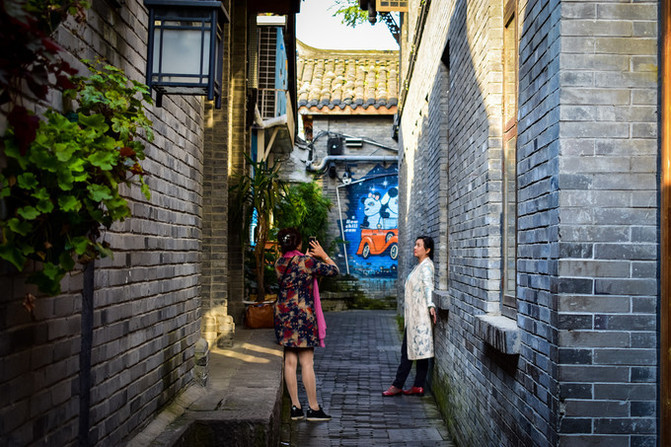

There are relatively few people in Jingli Lane, and it is close to the south of the narrow alley. The shops here are not as prosperous as the business in the two narrow alleys. The biggest attraction is that on the outer wall of the alley, there is a 500-meter-long brick culture wall of past dynasties and a 500-meter-long folk photo wall.




giant panda breeding base
The Chengdu Giant Panda Breeding Base is located in Futou Mountain in the northern suburbs of Chengdu City, more than 10 kilometers away from the urban area. There is a wide Panda Avenue connected to the urban area. It takes about 40 minutes to get there by car. It has become one of the main bases in China for ex-situ protection of rare and endangered wild animals such as giant pandas. Animals such as giant pandas, red pandas, black-necked cranes, white storks and white swans, black swans, geese, mandarin ducks and peacocks are raised all year round. Of course, I definitely came to Chengdu mainly to see our national treasure giant pandas.


You must go early to see giant pandas at the breeding base. There will be some feeding at noon. The giant pandas will doze off after lunch and are almost not very energetic in the afternoon. It is best to go and see them in the morning. The base has a large area and many subdivisions, and many small roads are circuitous and easy to get lost. However, there are many domestic and foreign teams visiting the Panda Base, so it's okay to follow behind them, and they can also listen to free explanations.



I arrived at the panda base at around ten o'clock in the morning. Some of the red pandas had already begun to doze off and crawled on the ground without moving.

Red pandas are generally quite shy. They hide in the tree hole and refuse to come out while being watched by so many people. They stick their heads out from time to time to satisfy people's curiosity, making them so cute.



In contrast, we have seen a lot of giant pandas in the world. I eat mine, you take your pictures, take one from the front and one from the side, as long as you are happy. She looked like a big idol star.




But to be honest, the giant panda's upper limbs are really dexterous, and its posture of grasping bamboo shoots is particularly skillful. After eating, he takes one after another. Coupled with his round figure, he is also a complete foodie. Although it is cute and cute, it never swallows food. It picks up the bamboo shoots, uses its teeth to peel off the outer parts layer by layer, and only eats the buds inside. This is also a tasteful eater.



Giant pandas belong to the only mammal in the order Carnivora, Uridae, the subfamily Giant Panda and the genus Giant Panda. That's right, it's the order Carnivorous. In fact, 90% of people don't know it. In fact, giant pandas originally ate meat. After evolution, 99% of their food was bamboo, but their teeth and digestive tract remain intact, so they are still classified as the order Carnivorous.

Young red pandas, like children, like to play and chase each other. They have round cheeks, big dark circles under their eyes, plump bodies, their iconic eight-character walking style, and sharp claws like scalpels.


Giant pandas have existed on earth for at least 8 million years and are known as "living fossils" and "national treasures of China". When traveling to Chengdu, you must check in here to get a closer look at these cutest animals in the world.

eastern suburb memory
Dongjiao Memory is located at No. 4 Jianshe South Branch Road on the east outer side of the Second Ring Road in Chenghua District, Chengdu City. It is the original Chengdu East District Music Park. It gathers many cultural forms such as music, art, drama, and photography. It is a diverse cultural park.



"Repairing the old as old and putting the old houses into new use" is the main feature of the memory architecture in the eastern suburbs. It combines the industrial aesthetics of the planned economy era with the functions of modern commercial buildings, and is compatible with the office buildings aided by the Soviet Union in the 1950s and the early 21st century. Office buildings, multi-storey factories and industrial chimney pipes create an artistic atmosphere of nostalgia and fashion in the memory of the eastern suburbs.




It retains the eucalyptus and sycamore trees unique to the original Chengdu Hongguang Electronic Tube Factory, and also uses used previously used machine tools, semi-finished glass shell products, used tanks, and pipes to transform them into art pieces, creating a memory of the eastern suburbs that is both nostalgic and fashionable. The artistic atmosphere. Tourists can fully experience the charm of industrial sites, experience the changes in urban development, and reminisce about memories from the past in the Eastern Suburb Memory Park.



[Western Sichuan Chapter]
Aba County, at the junction of Gansu, Qinghai and Sichuan provinces, has a unique geographical location and breeds distinctive national culture and beautiful scenery.
According to the "Annals of Nianbo Yeze Mountain", the "Lianbao Yeze" sacred mountain located south of Ando, the holy land of East Tibet, is one of the top ten sacred mountains in Tibet. When the sacred mountain that continues to be promoted enters the eleventh place, it will be the time when the sacred mountain enters the kingdom of heaven. The sacred "Lotus Baoye Ze" sacred mountain is very honored. Under the mercy and protection of the Buddha Lord, it has been promoted to the eighth place, ranking first among the sacred mountains in the Amdo region.
The destination of this trip is Lianbao Yeze, located in Aba County, western Sichuan. It takes ten hours from Chengdu to reach Aba County. Although the road is hard, the call of the beautiful scenery of western Sichuan makes me look forward to it.

Lianbao Yeze/Shitou Mountain
The "Lianbao Yeze" sacred mountain is located in the southwest of Aba County and takes about 60 minutes by car. According to "Lianbao Yeze Shenshan Chronicles", the Lianbao Yeze area was an ancient battlefield where King Gesar fought, and many stories of King Gesar are still told today. Lotus Baoye is not only a world of strange peaks and rocks full of fantasy and unpredictable, but also a masterpiece of nature full of infinite reverie.

Haizi is what local people in Xizang and Qinghai call inland lakes. Lianbao Ye is dotted with lakes in the scenic area and can be seen everywhere. The first scenic Haizi is called Dangzangeco, which means crystal clear lake. When the light and shadow are right, the surrounding mountains are reflected into the lake and clearly visible. The mountains, light and water are integrated and beautiful.



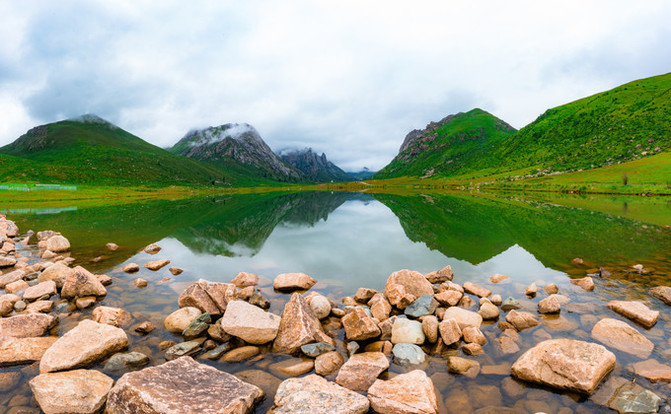
In front of Dangzangeco is Qudeng Cuo, also known as Baita Lake. The white tower next to the lake is tall and straight, reflecting the lake, and the lakes and mountains are full of poetry. It is unforgettable and a great place for photography.



Lotus Baoye means "jade peak of dignity" in Tibetan. The mountains are majestic and steep, and various strange stones are grown.
For example, this huge rock lies like a tiger on a green hillside. How did it appear here? This huge stone is called the "Flying Stone". There is also legend that it was kicked down from the stone mountain by King Gesar. It is very interesting.

There is also the combination of trees and stones. It is really a miracle that trees grow in stones and can still thrive.


There are more and more vivid natural stone landscapes in the back, such as General Rock, Bajie Wudao, Camel Peak, Eagle Striking in the Sky, Kiss for Thousands of Years, etc. Each of which is vivid, step by step, is a masterpiece of nature's magical craftsmanship.



The last and most amazing one is "Zagarcuo". "Zagar" means white rock."White" means holiness and auspicious in Tibetan culture, and "Cuo" means lake. "Zagarcuo" is a holy lake. "Zagar" covers an area of about 3 square kilometers and belongs to a typical ice-eroded lake formed by water accumulated in a glacier and ice-eroded basin. Every summer,"Zagarcuo" is crystal clear, and the mountains reflect on the lake. The hardness and softness are intertwined with each other, making it like a dream; every winter, the lake freezes, like a huge mirror, shining on the sun, moon, mountains and rivers. It is picturesque.



"Zagarcuo" is the sacred lake in the hearts of Tibetans. According to legend,"Zagartso" is a drop of holy water thrown by the Goddess of Mercy Bodhisattva when he enlightens all living beings. The holy water absorbs the essence of heaven and earth, gathers the spirit of snow mountains, and gradually gathers into a lake that penetrates the soul. It continuously flows to the downstream mountains, rivers, villages, and creatures deliver holy nectar, nourish the growth of all things, and purify the hearts of ordinary people.


It is said that as long as a pious person circles the sacred lake, his heart will be purified and he will receive happy blessings, which is very effective; especially those with destiny can still see the figure of the gods and their own souls on the mountains and in the water when the weather is clear or when the clouds are misty.

Pure Land Brahma/Gemo Temple
Early the next day, we set off for Kemo Temple. Kemo Temple is one of the three major temples of Tibetan Buddhism and one of the branches of Labrang Temple of the six major temples of the Gelug Sect, also known as Huiyuan Temple.


Walking into the temple, you will find the distinctive Tibetan style buildings of the Gelug Sect, which are majestic and solemn. There are five halls in the courtyard, and the one in the middle is the highest. When entering the main hall, no photos are allowed inside. There are special tour route instructions, and no loud noises are allowed. There were many incense tables and candlesticks in the hall, and Thangka and magic tools were hung around. Words couldn't describe the tranquility and tranquility.



Although photos are not allowed inside the main hall, they are allowed outside. The vermilion color of these Gelug Sect buildings is particularly eye-catching. Check-in photos is particularly artistic against the backdrop of light and shadow.



Wetland Grassland/Manzetang
Leave Gemo Temple and head to Manzetang Wetland. Along the road are infinitely beautiful Tibetan scenery, with green shades as wild, cattle and sheep flocks, and the fine weather with thousands of miles of clear skies, it is like walking in a painting. The driver was playing cheerful music while driving. The road behind him was not very smooth. Even so, it did not stop him from running. The car was like a runaway wild horse running deep into the endless grassland.
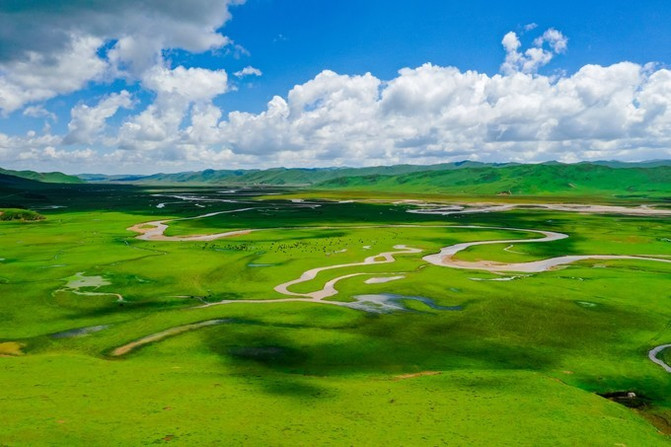

The Manzetang wet wetland includes grasslands in Maierma, Jialuo Township, Jiake Ranch and other places, with an average altitude of about 3400 meters. There are vast grasslands in the scenic area. The green grass is green and the sea of flowers and grass carpet is very beautiful. It is an excellent pasture in the northern Tibetan area of western Sichuan. It is also a plateau wetland cultivated at the source of the Yellow River system. The winding river stretches on the wetlands and grasslands, like a flying ribbon, setting off the colors of the blue sky and white clouds. It is beautiful everywhere you can see.


Lay on cushions, set up tents, and have a lunch under such a beautiful scenery, which will have a unique flavor. Beautiful food, free air, and happy mood are happening in the Manzetang Wetland. There is no more surprising and comfortable trip than this.


The sky is green and the wild is vast, and the wind blows on the grassland to see cattle and sheep. The beautiful Manzetang Wetland Grassland, with blue sky and white clouds as the quilt, the earth pastures as the bed, countless yaks and small wild animals inhabit this extreme scenery freely. This is also the place where Tibetans rely on to live. It is home and paradise.



Xanadu/Shenzuo Village
It takes 2 hours to travel from Manzetang Wetland to the next destination, Shenzuo Village. I started at 3 p.m. and had a beautiful nap on the car. Shenzuo Village is an original ecological natural scenic spot, with both forestry, animal husbandry and agriculture. It is peaceful and peaceful. It is especially suitable for people to live and live. It is an original ecological "paradise outside the world". The first time I heard the name of Shenza Village, I felt very fairy. I thought the name was given by people later. In fact, it has been called Shenza from ancient times to the present, just like the kindness and simplicity of Shenza Village that has continued since ancient times to the present. There are only 73 households in this village, backed by alpine pastures and facing the endless virgin forest across the river.



There is a viewing platform high in the village, which is known as the most beautiful viewing platform in Sichuan. It can overlook the panoramic view of the entire village and its surroundings. Climbing up the plank road built in the village will be very tiring because of the altitude, but the beautiful scenery does not live up to our expectations. The mountain where the observation deck is located is Goddess Mountain. There is a very beautiful legend about this sacred mountain. The shrine is famous for the goddess Gabanam and the shrine girl. The beauty of the shrine girl has become a legend in the Ando Tibetan area. The shrine was brought by a beautiful female mountain god. Opposite Goddess Mountain is Male God Mountain. The two sacred mountains face each other across the river and jointly protect Shenza Village.



Shenza Village is a sea of flowers. Whether in the village or on the hillside, all kinds of alpine flowers bloom competitively, like a large natural garden. It is so beautiful that it makes people forget to leave.


Beautiful scenery/Tongyangding
Arrive at Tongyangding at five o'clock in the afternoon. This is a very high hillside. Maybe that's why it got its name, the top of the mountain very close to the sun. There is a wooden plank road walking from the parking lot to the observation deck. At the end of the plank road is a restaurant and two connected observation platforms on the other side. The platform has a wide view and is surrounded by endless green fields. There are also residents. Curls of smoke rising from the homes of herders.



Behind the restaurant lies a bigger surprise. At the end of the wooden plank road, there are shocking scenery. Under the blue sky and white clouds, overlooking the majestic and solemn Langyi Temple, lying quietly on the green hills, clouds floating across the colorful roof, shining with golden light from time to time.



The restaurant in Tongyangding offers a variety of flavors of food, including Western food, Chinese food, Tibetan food, etc. When you come to Aba, of course, you must taste local specialties Tibetan food. Yak meat, milk tea, Tibetan hot pot, pepper chicken, homemade yogurt, beef steamed wheat... Authentic Tibetan flavor and traditional Tibetan eating methods are the most memorable taste of traveling in western Sichuan.


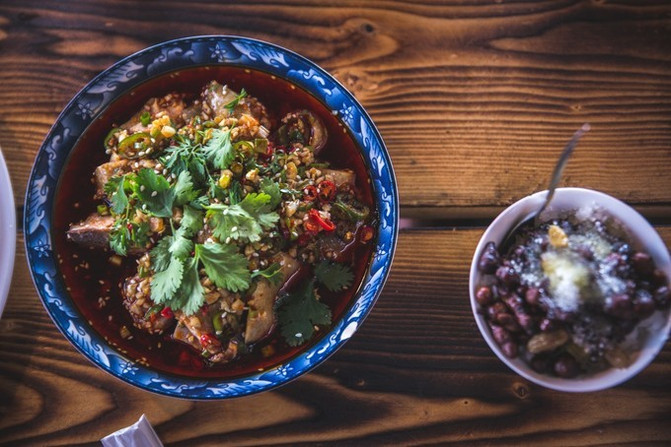


tail
After a full six days of round-trip, I get satisfaction. Damei Sichuan has such charm.
The ancient capital of Chengdu City, with different scenery and different life, we will see you again ~
Previous Article:The secret realm of southern Sichuan, the beauty of Renshou--A two-day self-driving journey in Renshou, Sichuan
Next Article:The fireworks of "Taste Chengdu" in childhood have returned to the streets and alleys
